August 17 - 23, 2014: Issue 176
His Masters Voice, Old 78’s and Australia’s Love of Music
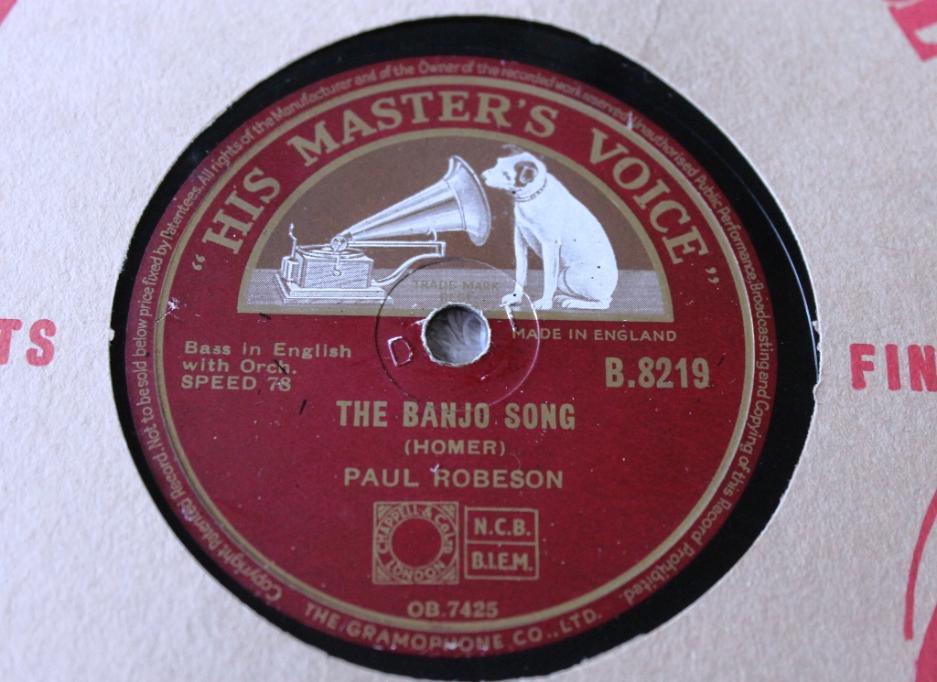
His Masters Voice, Old 78’s and Australia’s Love of Music
Among the curious objects that collect here are some very heavy and quite thick records that once required a beautiful old gramophone for their playing. Going through these, and marvelling at some in this ‘record collection’, prompted a small investigation into Australia’s love of music and when these Australian made editions first began to be produced here.
The story goes back further than this of course, Thomas Edison, working on the concept of reproducing sound, invented the Phonograph on July 18th, 1877, an invention, due to mail still arriving here by ship, that we did not ‘hear’ about until 1878 in any large measure. We found some old newspaper reports regarding this for your interest and these are listed under Extras. Prior to this invention the phonautograph is the earliest known device for recording sound. Previously, tracings had been obtained of the sound-producing vibratory motions of tuning forks and other objects by physical contact with them, but not of actual sound waves as they propagated through air or other media. Invented by Frenchman Édouard-Léon Scott de Martinville, it was patented on March 25, 1857. It transcribed sound waves as undulations or other deviations in a line traced on smoke-blackened paper or glass. A recent playback by a group of American historians of a phonautograph recording of Au clair de la lune made on April 9, 1860 is also cited as one early recording. While these other inventors produced devices that could record sounds, Edison's phonograph was the first to be able to reproduce the recorded sound.
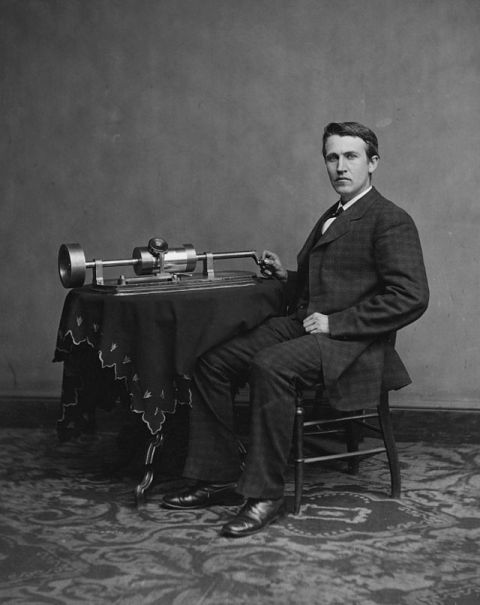 Edison’s first successful recording and reproduction of intelligible sounds were achieved early in the following December, used a thin sheet of tin foil wrapped around a hand-cranked grooved metal cylinder. Tin foil was not a practical recording medium for either commercial or artistic purposes though and the crude hand-cranked phonograph was only marketed as a novelty, to little or no profit. Edison moved on to developing a practical incandescent electric light and the next improvements to sound recording technology were made by others.
Edison’s first successful recording and reproduction of intelligible sounds were achieved early in the following December, used a thin sheet of tin foil wrapped around a hand-cranked grooved metal cylinder. Tin foil was not a practical recording medium for either commercial or artistic purposes though and the crude hand-cranked phonograph was only marketed as a novelty, to little or no profit. Edison moved on to developing a practical incandescent electric light and the next improvements to sound recording technology were made by others.
Charles Sumner Tainter, Alexander Graham Bell and Chichester Bell introduced wax as the recording medium and engraving, rather than indenting, as the recording method. In 1887, their "Graphophone" system, which recorded dictation on disposable cardboard tubes with a thin wax coating, was being put to the test of practical use by official reporters of the US Congress. After this system was demonstrated to Edison's representatives, Edison quickly resumed work on the phonograph. He settled on a thicker all-wax cylinder, the surface of which could be repeatedly shaved down for reuse. Both the Graphophone and Edison's "Perfected Phonograph" were commercialized in 1888. Eventually, a patent-sharing agreement was signed and the wax-coated cardboard tubes were abandoned in favor of Edison's all-wax cylinders as an interchangeable standard format.
Beginning in 1889, prerecorded wax cylinders were marketed. These had professionally made recordings of songs, instrumental music or humorous monologues in their grooves. At first, the only customers for them were proprietors of nickel-in-the-slot machines — the first "juke boxes" — installed in arcades and taverns, but within a few years private owners of phonographs were increasingly buying them for home use. Each cylinder could easily be placed on and removed from the mandrel of the machine used to play them. Unlike later, shorter-playing high-speed cylinders, early cylinder recordings were usually cut at a speed of about 120 rpm and could play for as long as three minutes. They were made of a relatively soft wax formulation and would wear out after they were played a few dozen times. The buyer could then use a mechanism which left their surfaces shaved smooth so new recordings could be made on them.
Picture: Edison wax cylinder phonograph ca. 1899 - Edison Home Phonograph, Suitcase-Model courtesy Norman Bruderhofer,www.cylinder.de
EDISON'S PHONOGRAPH. Mr. Edison has prepared a phonograph to receive a speech to be delivered by Mr. Gladstone. EDISON'S PHONOGRAPH. (1889, January 12). Launceston Examiner (Tas. : 1842 - 1899), p. 2. Retrieved from http://nla.gov.au/nla.news-article38342093
The Phonograph. This recent invention of the ingenious Edison has been a great attraction since it was exhibited in Grafton, and there are few citizens who have not listened to the melodies and other sounds reproduced by it. It was exhibited in the Convent school on Wednesday, and the pupils were much entertained by the reproducing capabilities of the instrument, the solos being distinctly heard through the building. Some eighteen items were given, including the Marseillaise, Mona, Annie Laurie, Lovers Serenade, Strauss, cornet solo, the Kerry dance. Miss Mamie Morrissey, one of the pupils, sang a solo in the instrument, which was immediately afterwards reproduced to the delectation of the audience, not excepting the vocalist herself. The invention is a marvel. The sounds are conveyed through a tube, making small impressions like waves on a rotating cylinder, from whence they are given off by a small appliance as the cylinder revolves. The sounds once obtained can be reproduced thousands of times, and through the instrument one may listen to songs rendered by the most talented vocalists of the day. An entertainment will be given with the phonograph at the Smith Grafton School of Arts on Monday evening, when a song from the Mayoress will be taken and reproduced to tile audience. Exhibitions will be given at the various district, centres, afterwards on the Richmond and Southern rivers. The Phonograph. (1893, July 22). Clarence and Richmond Examiner(Grafton, NSW : 1889 - 1915), p. 8. Retrieved from http://nla.gov.au/nla.news-article6125207
It is also worth noting that the word ‘phonograph’ had been used prior to this invention as a term for "sound writing", derived from the Greek words φωνή (meaning "sound" or "voice" and transliterated as phonē) and γραφή (meaning "writing" and transliterated as graphē). The similar related terms gramophone and graphophone have similar root meanings. The roots were already familiar from existing coinages such as photograph ("light writing"), telegraph ("distant writing") and telephone ("distant sound"). The new term may have been influenced by the existing words phonographic and phonography, which referred to a system of phonetic shorthand; in 1852 The New York Times carried an advertisement for "Professor Webster's phonographic class", and in 1859 the New York State Teachers' Association tabled a motion to "employ a phonographic recorder" to record its meetings.
This is also occurred here in Australia:
EDUCATION PHONOGRAPHIC SHORTHAND. — Mr. D. F. MACDONALD will COMMENCE a CLASS for the STUDY of SHORTHAND Writing on Monday evening, March 12, at 8 pm. Terms for the complete Course of 16 Lessons, Two Guineas, payable in fortnightly instalments in advance.' Intending students apply at once at Mr. Parker's, Chemist, Gawler-place. Advertising. (1877, March 8). South Australian Register(Adelaide, SA : 1839 - 1900), p. 1. Retrieved from http://nla.gov.au/nla.news-article40784983
In the 1890s, Emile Berliner initiated the transition from phonograph cylinders to flat discs with a spiral groove running from the periphery to near the center. Other improvements were made throughout the years, including modifications to the turntable and its drive system, the stylus or needle, and the sound and equalization systems. For us the British English, "gramophone" referred to any sound-reproducing machine using disc records, which were introduced and popularized in the UK by the Gramophone Company, based in the United Kingdom, which was one of the early recording companies, founded by William Barry Owen and his partner/investor Trevor Williams in 1897 as the UK partner of Emile Berliner's United States based United States Gramophone Company(founded 1892), and as such was the parent organization for the famous "His Master's Voice" (HMV) label.
This company was merged with another in 1931 to form Electric and Musical Industries Limited (EMI), but the company title as "The Gramophone Company Limited" continued in use in the UK into the 1970s, and could be seen on sleeves and labels of records such as Pink Floyd’s The Dark Side of the Moon vinyl copies of which bear the copyright notice "©1973 The Gramophone Company, Ltd."). (1.)
78’s
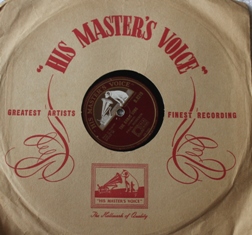 Any flat disc record, made between about 1898 and the late 1950s and playing at a speed around 78 revolutions per minute is called a "78" by collectors. The materials of which discs were made and with which they were coated were also various, but most were made from shellac and ground slate; shellac eventually becoming the commonest material. During and after World War II when shellac supplies were extremely limited, some 78 rpm records were pressed in vinyl instead of shellac (wax), particularly the six-minute 12" 78 rpm records produced by V-Disc for distribution to US troops in World War II.
Any flat disc record, made between about 1898 and the late 1950s and playing at a speed around 78 revolutions per minute is called a "78" by collectors. The materials of which discs were made and with which they were coated were also various, but most were made from shellac and ground slate; shellac eventually becoming the commonest material. During and after World War II when shellac supplies were extremely limited, some 78 rpm records were pressed in vinyl instead of shellac (wax), particularly the six-minute 12" 78 rpm records produced by V-Disc for distribution to US troops in World War II.
78s come in a variety of sizes, the most common being 10 inch (25 cm) and 12 inch (30 cm) diameter, and these were originally sold in either paper or card covers, generally with a circular cutout allowing the record label to be seen. Since most 78 rpm discs were issued in paper sleeves with no additional accompanying materials, relatively limited information is provided by the items themselves.
Earliest speeds of rotation varied widely, but by 1910 most records were recorded at about 78 to 80 rpm. In 1925, 78.26 rpm was chosen as a standard for motorized phonographs, because it was suitable for most existing records, and was easily achieved using a standard 3600-rpm motor and 46-tooth gear (78.26 = 3600/46). Thus these records became known as 78s (or "seventy-eights"). This term did not come into use until after World War II when a need developed to distinguish the 78 from other newer disc record formats. Earlier they were just called records, or when there was a need to distinguish them from cylinders, disc records.
The durations of 78 RPM recordings is about three to five minutes per side, depending on the disc size: 12": ca. four to five minutes and 10": ca. three minutes. As late as the 1970s, some children's records were released at the 78 rpm speed. The older 78 format continued to be mass produced alongside the newer formats into the 1950s, but had faded from the scene by 1955. (2.)
His Master's Voice, abbreviated HMV, is a trademark in the music business, and for many decades was the name of a large record label. The name was coined in 1899 as the title of a painting of the dog Nipper listening to a wind-up gramophone. In the photograph on which the painting was based, the dog was listening to a phonograph cylinder.
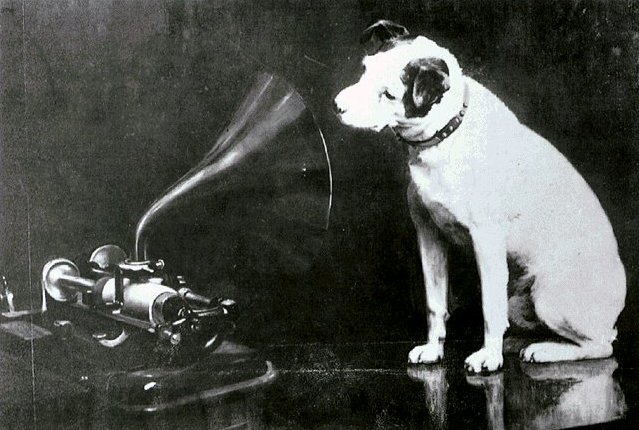
Original Nipper- Francis Barraud (1856–1924)
Nipper was born in 1884 in Bristol, England, and died in September 1895. It has been claimed in various sources that he was a Jack Russell Terrier, a Fox Terrier, or "part Bull Terrier". He was named Nipper because he would bite the backs of visitors' legs. Nipper originally lived with his owner, Mark Henry Barraud, in the Prince's Theatre where Barraud was a scenery designer. When Barraud died in 1887, his brothers Philip and Francis took care of the dog. Nipper himself died in 1895 and was buried in Kingston upon Thames in Clarence Street, in a small park surrounded by magnolia trees. As time progressed the area was built upon, and a branch of Lloyds Bank now occupies the site. On the wall of the bank, just inside the entrance, a brass plaque commemorates the terrier that lies beneath the building.
In 1898, three years after Nipper's death, Francis Barraud, his last owner and brother of his first owner, painted a picture of Nipper listening intently to a wind-up Edison-Bell cylinder phonograph. On February 11, 1899, Francis filed an application for copyright of his painting "Dog Looking At and Listening to a Phonograph".Thinking the Edison-Bell Company located in New Jersey, USA, might find it useful, he presented it to James E. Hough, who promptly said, "Dogs don't listen to phonographs". On May 31, 1899, Barraud went to the Maiden Lane offices of The Gramophone Company with the intention of borrowing a brass horn to replace the original black horn on the painting. Manager William Barry Owen suggested that if the artist replaced the machine with a Berliner disc gramophone, the company would buy the painting. A modified form of the painting became the successful trademark of Victor and HMV records, HMV music stores, and RCA. The trademark itself was registered by Berliner on July 10, 1900.
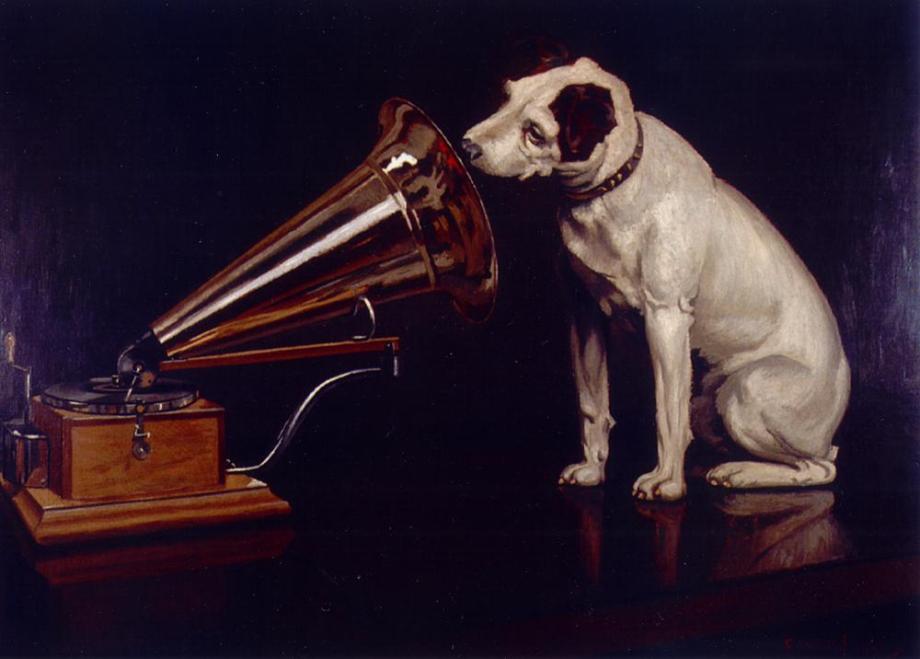
The 'His Masters Voice' painting with Gramaphone inserted.
The slogan "His Master's Voice", along with the painting, was sold to The Gramophone Company for 100 pounds sterling - 50 pounds for the copyright and 50 pounds for the painting itself. Francis Barraud said : "It is difficult to say how the idea came to me beyond that fact that it suddenly occurred to me that to have my dog listening to the phonograph, with an intelligent and rather puzzled expression, and call it 'His Master's Voice' would make an excellent subject. We had a phonograph and I often noticed how puzzled he was to make out where the voice came from. It certainly was the happiest thought I ever had." (3.)
Other sources state Nipper would listen to a recording of Mark Barraud’s voice intently, and this is where the happy inspiration may stem from:
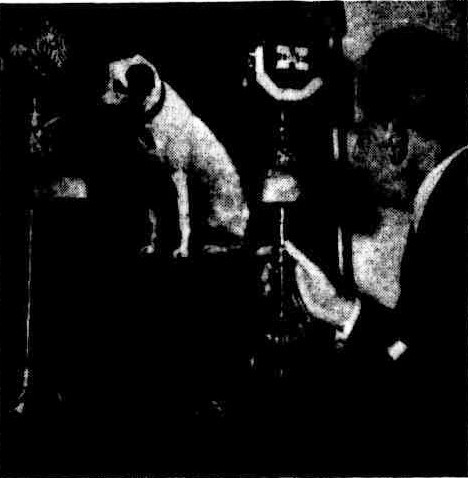 Sir Ernest Fisk Here With H.M.V. Souvenirs. The original His Master's Voice "Dog and' Trumpet" painting will be( on show at the company's1 stand at this year's Royal Easter Show in Sydney. The company's Royal silver and gold microphones used by the Queen Mother, and Queen Elizabeth for the launching of the liners Queen Mary and Queen. Elizabeth will also be exhibited. The Governing Director of Electric and Musical Industries1 (Australia).Pty. Ltd., Sir Ernest Fisk, said yesterday that the painting and the microphones were brought to Australia as1 part of the company's golden jubilee celebrations to be held this year.
Sir Ernest Fisk Here With H.M.V. Souvenirs. The original His Master's Voice "Dog and' Trumpet" painting will be( on show at the company's1 stand at this year's Royal Easter Show in Sydney. The company's Royal silver and gold microphones used by the Queen Mother, and Queen Elizabeth for the launching of the liners Queen Mary and Queen. Elizabeth will also be exhibited. The Governing Director of Electric and Musical Industries1 (Australia).Pty. Ltd., Sir Ernest Fisk, said yesterday that the painting and the microphones were brought to Australia as1 part of the company's golden jubilee celebrations to be held this year.
"The painting has hung in the company's board room since it was painted 50 years ago and is insured for £5,000." Sir Ernest said. "The microphones are insured for £2,000. Francis Barraud painted the picture in 1899. Barraud's brother died and left his dog, 'Nipper,' and a recording of his voice to Barraud. When Barraud played the record of his dead brother's voice, the dog trotted over to the trumpet, cocked his head to one side, and listened. Barraud painted a picture of this and tried to sell it to the Edison Recording Company, who manufactured the trumpet. The Edison company refused the painting and Barraud offered it to H.M.V. They suggested that they would be more interested if the trumpet was an H.M.V. product. Barraud repainted the gramophone. The outline of the old instrument is still visible in the painting. H.M.V.. paid Barraud £. 100 for the original, but commissioned Barraud to paint copies," Sir Ernest said.
After the Royal Show, the painting and microphones will be exhibited throughout Australia. Sir Ernest Fisk Here With H.M.V. Souvenirs. (1950, February 28). The Sydney Morning Herald (NSW : 1842 - 1954), p. 4. Retrieved from http://nla.gov.au/nla.news-article18144857
In British Commonwealth countries, the Gramophone Company did not use this design on its record labels until 1909. The following year the Gramophone Company replaced the Recording Angel trademark in the upper half of the record labels by the Francis Barraud picture commonly referred to as Nipper, or The Dog. The company was not formally called "HMV" or His Master's Voice, but was identified by that term because of its use of the trademark. Records issued by the company before February 1908 were generally referred to as "G&Ts", while those after that date are usually called "HMV" records.
As recorded throughout some of our history pages music has always been part of our culture, music arrived with the First Fleet – later, excursionists steamers to Pittwater all had bands that would play, even the selling of land out here, in its earliest big sale days, was call for a band to be engaged and entertain the prospective buyers. The phenomenon of music, and voice recordings, of being able to have your own ‘in home concerts’ for a land isolated, and people within it living at some distance from ‘the city’ was embraced with open arms in this pre-radio era. What could be better than hearing the voice of your king or queen instead of reading ewhat they may have said in a newspaper?
PHONOGRAPH. Since the removal of the Phonograph entertainments to the premises at 326 George-street, the exhibitions have been of a more interesting nature, as visitors are enabled to more closely examine the instrument, and to listen to the records by means of their tubes and any information desired in reference either to the records or to the instrument is readily supplied. During the whole of the day on Saturday there were large audiences, and the management has determined during this week to introduce a number of new records, and to commence the entertainments at 10 a m and continue them to 9.30 pm. The new premises are well adapted for the exhibitions.PHONOGRAPH. (1890, December 29). The Sydney Morning Herald (NSW : 1842 - 1954), p. 7. Retrieved fromhttp://nla.gov.au/nla.news-article13778966
The Gramaphone. We have had an opportunity of inspecting the above wonderful invention, which is now being introduced for parlour use. It is a kindred instrument to the phonograph, but a great advance has been made, inasmuch as the songs, musical items , and recitations reproduced by the gramophone can be heard distinctly without the use of the ear boll. It reproduces all hinds of sounds with unerring accuracy, and it is manipulated without the least difficulty. Each machine is supplied with a number of sounding plates, representing a capital variety of songs, instrumental pieces, recitations, &c., and these can be reproduced at will by the operator, it being very easy to adjust the plates. With one of these instruments on a table a company can be entertained with the very latest songs as sung by the loading vocalists of the day, selections by notable brass bands, and instrumental solos, and recitations by distinguished elocutionists. We had the pleasure of hearing the reproduction of a number of these items, and there is no doubt that the gramaphone is really a marvellous instrument. The Gramaphone. (1896, December 29). Goulburn Evening Penny Post (NSW : 1881 - 1940), p. 2. Retrieved from http://nla.gov.au/nla.news-article98558027
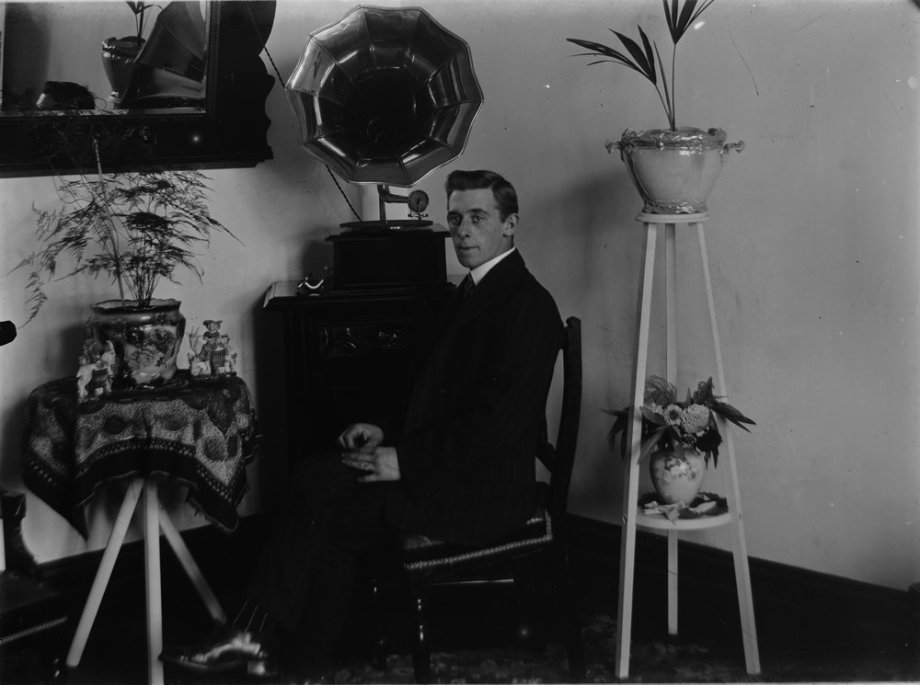
Man seated beside a gramaphone and speaker, circa 1900-1915, Image No.: db106554, courtesy State Library of Victoria.
The illustrated song and biograph entertainment, which was given on Tuesday evening last in St. Joseph's (Woollahra) schoolroom, under the auspices of the local C.Y.M. Society, was a pronounced success. The building was crowded long before the performance began. The programme was an excellent one. Special records were given by the gramaphone, in which Madame Melba, in 'Ave Maria,' Amy Castles, in 'Serenade,' and Marie Narella, in 'Killarney,' were heard with advantage, whilst the biograph supplied moving pictures of a high standard, causing considerable applause. OUR YOUNG MEN. (1907, May 2). Freeman's Journal (Sydney, NSW : 1850 - 1932), p. 29. Retrieved from http://nla.gov.au/nla.news-article111278046
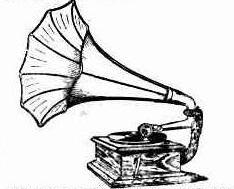 CLAPHAM AND CO. FOR GRAMAPHONES. One of our friends wanted me to choose for him some more records, so I again called in on Clapham and Co., at 318 George street, just below Paling's. I was more than ever convinced that the Gramaphone was "the" machine, as the glorious notes of Melba and Caruso were interpreted in such a magnificent manner that one found it hard to believe the artists were not actually singing in the room.
CLAPHAM AND CO. FOR GRAMAPHONES. One of our friends wanted me to choose for him some more records, so I again called in on Clapham and Co., at 318 George street, just below Paling's. I was more than ever convinced that the Gramaphone was "the" machine, as the glorious notes of Melba and Caruso were interpreted in such a magnificent manner that one found it hard to believe the artists were not actually singing in the room.
The prices of the machines varied from £9 upwards, but even a small machine gave an excellent result. Country friends can have their records sent to them on approval. This is a good system in vogue at Clapham's, enabling clients hundreds of miles away to choose their records. Monthly pamphlets describe the new records coming forward, and are sent on, post free, to all gramaphone owners. If you haven't got a machine let me know, and I will forward catalogues; and if you have a machine, communicate with the firm and they will send the monthly pamphlet to you direct. "JACK." SMART GLOVES AT W. T. WATERS AND CO.'S, LTD. (1909, June 17). Watchman (Sydney, NSW : 1902 - 1926), p. 3. Retrieved from http://nla.gov.au/nla.news-article115096463
As demand grew it was clear an onshore manufacturer was needed. For a population for the whole of Australia in 1925 of 5,939,231, and in NSW: 2,300,000 at the end of 1925, the statistics for record sales were in themselves a phenomenon, especially considering the cost of these initial sound recordings:
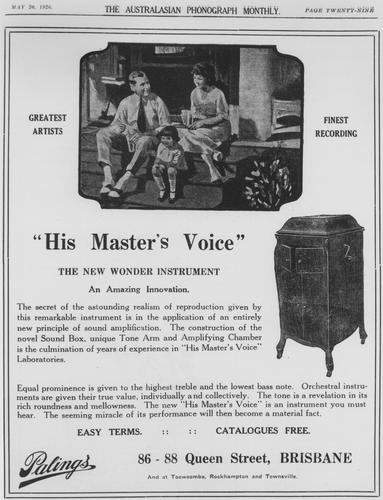 GRAMOPHONES. A SYDNEY FACTORY. LONDON, May 6. The Gramophone Company, Ltd., manufacturers of "His Master's Voice" machines, intends to open a factory at Erskineville, Sydney. The company expects to commence the production of Australian-made gramophones and records in September. A manager and 12 departmental heads will sail in June. Four hundred employees will be engaged in Sydney. The manager of Hoffnung and Co., Ltd. (Mr. L. S. Barnett), referring to the foregoing announcement of the Gramophone Company's new undertaking, stated that his company, as agents, had received information from their Principals that it was intended to convert a commodious factory at Erskineville, which had been acquired from the Gold Hosiery Company, Limited. He expected that the managerial and technical staff would arrive in Sydney in July.GRAMOPHONES. (1925, May 7). The Sydney Morning Herald(NSW : 1842 - 1954), p. 9. Retrieved from http://nla.gov.au/nla.news-article16222472
GRAMOPHONES. A SYDNEY FACTORY. LONDON, May 6. The Gramophone Company, Ltd., manufacturers of "His Master's Voice" machines, intends to open a factory at Erskineville, Sydney. The company expects to commence the production of Australian-made gramophones and records in September. A manager and 12 departmental heads will sail in June. Four hundred employees will be engaged in Sydney. The manager of Hoffnung and Co., Ltd. (Mr. L. S. Barnett), referring to the foregoing announcement of the Gramophone Company's new undertaking, stated that his company, as agents, had received information from their Principals that it was intended to convert a commodious factory at Erskineville, which had been acquired from the Gold Hosiery Company, Limited. He expected that the managerial and technical staff would arrive in Sydney in July.GRAMOPHONES. (1925, May 7). The Sydney Morning Herald(NSW : 1842 - 1954), p. 9. Retrieved from http://nla.gov.au/nla.news-article16222472
Right: Advertisement for His Master's Voice phonographic sound box, 1926; UnidentifiedAustralasian Phonograph Monthly20 May 1926: courtesy John Oxley Library, State Library of Queensland
HIS MASTER'S VOICE IN AUSTRALIA - Premier Opens Factory. We were bidden by the Gramophone Co., Ltd., to attend the opening ceremony of 'His Master's Voice' new works, Railway Parade, Erskineville. The occasion was unique for Australia. We left town by motor, and bowled along very comfortably enough to Redfern-street. From there through Botany road and, along Henderson-road we suffered much from the outrageous state of the roads. Bruises, However, wore forgotten in the warm welcome extended to us by Mr. W. Manson, a member of the executive of the Gramophone Co., Ltd., and manager of the Australian and New Zealand branch. Very complete arrangements were made for the comfort of the guests, who were divided into small parties, each of which was placed in charge of a guide, who was consumed with the apostolic fire of communication, and we learned something about the making of many records. Led by Mr. Lang's party, the guests proceeded from the offices to the room in which are erected the record presses. These presses are so wonderfully constructed that, although a 10in record is subjected to a pressure of about 70 tons, the whole thing is worked with virtually no exertion on the part of the operator. Matrices (or reproductions on Nickeled copper, facsimiles of the original records) were fitted in the presses, labels put on the centre pins, and then the material, which had been sufficiently melted on the adjacent steam table, was inserted and the press closed down. After the steam heat has been turned off, icy cold water from the refrigerator was run through the pipes, cooling the records sufficiently to enable the operator to take them out of the press. Some time ago 'His Master's Voice.' was honoured by the King and Queen, and also by the Prince of Wales, by being asked to record their voices. The King and Queen gave addresses to the boys and girls of the Empire respectively, and the Prince of Wales gave an address on 'Sportsmanship.' The entire profits of these recordings were given to charities selected by the King and Queen and the Prince. It was only fitting that at the opening of the Australian factory these records should take precedence of all others, and Mr. Lang himself pressed a record by their Majesties the King and Queen. We next visited a room where all records which had been pressed are examined by inspectors, and if the slightest mark or fault appears, the records are at once broken up. Those which are passed by the inspectors are then sent to benches, where machines are fitted up for polishing the edges. After this, the records come under the hands of other inspectors, and are finally handed to others, who look after their boxing and shipping. After leaving the inspection room, we had a look at the great pressure tank which controls the pressure necessary for making the records. We then had a glance at the boiler house, the electrical machinery, and the refrigerator, after which we watched girls making the cardboard boxes in which the records are packed. Everyone was delighted with the bright, spacious canteens which the company has fitted up for their workers. The next department we visited was, perhaps, one of the most marvellous in the factory. In this department, working matrices are made from the mother matrices which have been dispatched from the Old Country. The process is intricate and delicate, and the guests were most interested in the various processes these matrices have to undergo. After the visit of inspection, Mr. Lang opened the proceedings by proposing the health of His Majesty the King, and afterwards made a few remarks, chiefly political, closing with a brief appreciation of the splendid enterprise of the company. Mr. Manson, who has a beautifully cultivated voice, replied, and thanked Mr. Lang, on behalf of the company, for honouring them by presiding at the opening ceremony of 'His Master's Voice' Australian factory. It was a very well-worded and effective speech. The toast of the Premier's health concluded the ceremony. While the Premier's speech was being made, a number of Royal records had been pressed and boxed, and were presented to each of the guests when leaving. HIS MASTER'S VOICE IN AUSTRALIA. (1926, January 24).Sunday Times (Sydney, NSW : 1895 - 1930), p. 3. Retrieved from http://nla.gov.au/nla.news-article128119007
HIS MASTER'S VOICE - Factory in Australia. Gramophone records are in such demand in Australia that the Gramophone Company Limited, of London, in order to cope with the large sale off 'His Master's Voice' and 'Zonophone' records has recently opened new works at Railway Parade, Erskinville, New South Wales. Mr. Max J. Alexander, Adelaide manager of S. Hoffnung & CO. Limited (who are the sole concessionaires for 'His Master's Voice' and 'Zonophone' records), was present at the opening ceremony of the new works, which, was performed by Mr. Hang, Premier of New South Wales. Mr. Alexander saw when interrogated on the subject: — 'The company's new works at Erskinville are modelled on the great works of the Gramophone Company Limited at Hayes, Middlesex. 'All the records sold by the company in Australia were formely produced at our Hayes Middlesex factory, but the demand for 'His Master's Voice' and 'Zonophone records became so great' in Australia that it was decided to build a factory in New South Wales. By this means the company will be able to cope with the large demand, a thing which has been found impossible in the past.' At the moment the company is employing approximately 100 work people, who are now working two shifts a day. An aggregate of 27,000 records is being turned out daily. With the three shifts which will shortly, have to be started the output will naturally be much larger.' "HIS MASTER'S VOICE". (1926, February 13). The Mail(Adelaide, SA : 1912 - 1954), p. 14. Retrieved from http://nla.gov.au/nla.news-article58514777
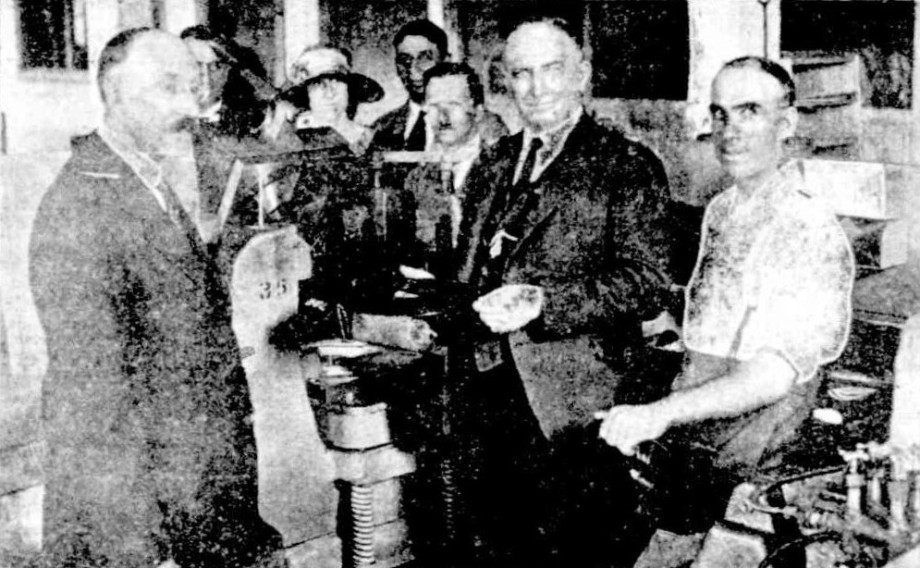
Above: Recently the "His Masters Voice" Gramophone Co. commenced pressing gramophone records in a large new factory in New South Wales. Above, the Lord Mayor of Sydney (Alderman Stokes) is shown with a record he has just pressed, using the very latest type of machine. No title. (1926, April 4). Sunday Times (Perth, WA : 1902 - 1954), p. 1 Section: Second Section. Retrieved from http://nla.gov.au/nla.news-article58239229
ADVANCE IN GRAMOPHONE CONSTRUCTION. Something entirely new in the way of gramophone manufacture is the new H.M.V. machine with the pleated diaphragm, invented by " M. Louis Lumiere, a famous French scientist". This pleated diaphragm does away with sound-box and tone-arm, and it is claimed that this new form, of reproduction gives the absolute tone and volume of the original, music, and that it represents a most remarkable achievement in the science of acoustics. ADVANCE IN GRAMOPHONE CONSTRUCTION. (1925, September 12). Barrier Miner (Broken Hill, NSW : 1888 - 1954), p. 6. Retrieved fromhttp://nla.gov.au/nla.news-article45908175
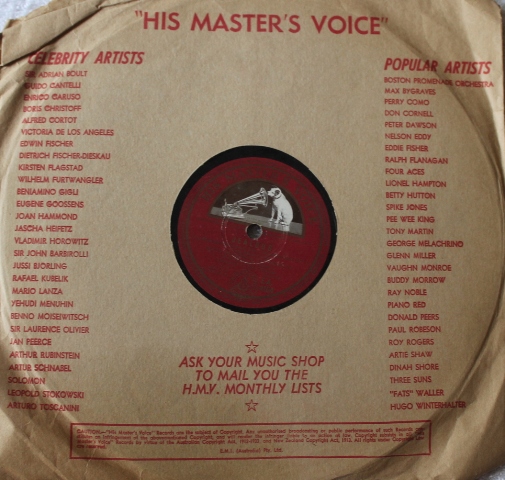 'HIS MASTER'S VOICE' FACTORY CELEBRATES FIRST BIRTHDAY. 'His Master's Voice' gramophone record factory had its first birthday anniversary last Tuesday. And out at Erskineville the company entertained the State Governor and a number of musical and commercial men. Upon the arrival of the Governor, the party was conducted through the factory, and the various processes of record manufacture were explained by the manager'(Mr. .W. Manson) and members of his staff. It is an intricate but nevertheless interesting business, the way the various positive and negative matrices arc made, before obtaining the final stamper shell, from which the' records the pressed. Particular care is taken that no record with the slightest fault gets past the examiners before being packed for sale to the public. 'At the subsequent function, the Governor proposed the health of the Gramophone Company,' Ltd. 'This factory was the first of its kind to be established in Australia, for the complete production of records,' he said. 'It is already making records,' he said. 'It is already making arrangements to increase its production, particularly with a view to further exploiting the possibilities of trade with places adjacent to Australia. Production so far has run into some millions of records, which speaks volumes for the foresight of those who established it, and the adaptability, and skill of the Australian operatives employed. ' In twelvemonths they have risen from absolute ignorance of the work, to a remarkable degree of efficeincy. 'The strides taken in the development of the gramophone are remarkable,' went on the Governor, 'when one considers that only 25 years ago the talking machine was looked upon as a quaint scientific toy. The time has arrived when the gramophone should find its place in everyone of our schools, when our boys and girls, just as they now form a taste for good literature by reading Shakespeare, Dickens, and Keats, should have their taste for music cultivated at school by hearing gramophone reproductions of great artists' , performances of the works of Chopin, Beethoven, Wagner, and others. New Zealand has realised what can be done in this direction, and already its schools are provided with gramophones and records.' The His Master's Voice label appears on records in 80 different languages and over 1000, different dialects.
'HIS MASTER'S VOICE' FACTORY CELEBRATES FIRST BIRTHDAY. 'His Master's Voice' gramophone record factory had its first birthday anniversary last Tuesday. And out at Erskineville the company entertained the State Governor and a number of musical and commercial men. Upon the arrival of the Governor, the party was conducted through the factory, and the various processes of record manufacture were explained by the manager'(Mr. .W. Manson) and members of his staff. It is an intricate but nevertheless interesting business, the way the various positive and negative matrices arc made, before obtaining the final stamper shell, from which the' records the pressed. Particular care is taken that no record with the slightest fault gets past the examiners before being packed for sale to the public. 'At the subsequent function, the Governor proposed the health of the Gramophone Company,' Ltd. 'This factory was the first of its kind to be established in Australia, for the complete production of records,' he said. 'It is already making records,' he said. 'It is already making arrangements to increase its production, particularly with a view to further exploiting the possibilities of trade with places adjacent to Australia. Production so far has run into some millions of records, which speaks volumes for the foresight of those who established it, and the adaptability, and skill of the Australian operatives employed. ' In twelvemonths they have risen from absolute ignorance of the work, to a remarkable degree of efficeincy. 'The strides taken in the development of the gramophone are remarkable,' went on the Governor, 'when one considers that only 25 years ago the talking machine was looked upon as a quaint scientific toy. The time has arrived when the gramophone should find its place in everyone of our schools, when our boys and girls, just as they now form a taste for good literature by reading Shakespeare, Dickens, and Keats, should have their taste for music cultivated at school by hearing gramophone reproductions of great artists' , performances of the works of Chopin, Beethoven, Wagner, and others. New Zealand has realised what can be done in this direction, and already its schools are provided with gramophones and records.' The His Master's Voice label appears on records in 80 different languages and over 1000, different dialects.
'The British Museum has now started to store matrices of great present-day artists, supplied to them by the Gramophone Company. There is a stipulation that these shall not be touched for 50 years, and then, they will become the property of the nation in perpetuity, so that future generations may hear reproductions of the voices of our great musical artists, as well as their own.' "HIS MASTER'S VOICE" FACTORY CELEBRATES FIRST BIRTHDAY. (1927, February 6). Sunday Times (Sydney, NSW : 1895 - 1930), p. 2. Retrieved fromhttp://nla.gov.au/nla.news-article128518833
Via this (above) official first day was February 1st, 1926, even though officially opened in January, 1926. A little on the popularity of being able to creae your own 'conceret at home' in Australia:
PHONOGRAPHS. Ten Million Records a Year - NEW INDUSTRY. From a thousand music shops talking machines blare the syncopated musical nonsense at the hour; from a hundred others issue the quieter more arresting, strains of the Classics of music and song: elsewhere the talking machines explain music, teach languages, and direct how the "daily dozen" gymnastic exercises should be carried out. Indeed, the talking machine and its sine qua non the phonograph record, have brought music to almost every home and sleepless nights to many suburban streets. But more amazing and interesting, as all these things, is the growth of the manufacture of phonograph records in Sydney, the only Australian city where factories have been established. Although the Brunswick- Balke-Collender Company has been manufacturing records for only three years, and the remaining companies, the Columbia Graphophone Company. Ltd., and the Gramophone Company. Ltd. opened their factories only last year, the three firms are now producing more than ten million records annually, a total that will be increased and even doubled, very shortly, it is expected.
Each of the companies has found such amazing demand for their products that they have been working more than one shift, and the Brunswick Company claims that their machines never stop during the whole twenty four hours. This company within a few weeks will be manufacturing its own compound or composition for the records, a departure that will shortly also be made by the Columbia Company.
Another company, the Parlorphone Company, is about to enter the field of phonograph record production. It is gratifying to note that, without exception, the manufacturers pay a tribute to their Australian workmen. Each at first imported experts from overseas, but the Australians, it was found, acquired a knowledge of the intricate processes with remarkable facility.
The Columbia Company is the first to begin actual recording in Australia, and this is being done by the new electric process-a development of the wireless microphone. By this method music at the Town Hall or the Conservatorium may be conveyed to the factory at Homebush by land line and recorded here. In future Sydney people will be able to obtain a lasting record of local artists, great visitors and possibly of the speeches and the enthusiasm at historic gatherings.
But the usefulness of the phonograph record is not confined to music and song. One of its most interesting uses is in teaching. In the interpretation of a classic the teacher will stop the student and say, "Now Just listen to Kreisler's phrasing of the same subject, and the student will be led to appreciate-even if he cannot emulate-the masters. Then there are courses of physical exercises and wireless courses.
Some of the companies believe that in future of the phonograph lies along the road of classic music. The Gramophone Company, makers of His Master's Voice and Zonophone records, are particularly insistent upon this. This opinion is not generally held, how-ever and at least one of the manufacturing firms believes that the greater demand will always be tor the popular song and musical "hits" of the hour; for Jazz and saxophones. PHONOGRAPHS. (1927, January 12). The Sydney Morning Herald (NSW : 1842 - 1954), p. 19. Retrieved fromhttp://nla.gov.au/nla.news-article16346618
Those among our collection contain records from all these early Australian manufacturers which, if we chose to sell them now, would only fetch between $20.00-$100.00 in Euros, Australian and US dollars as there is a demand by collectors for such items but still a fair amount of these everywhere.
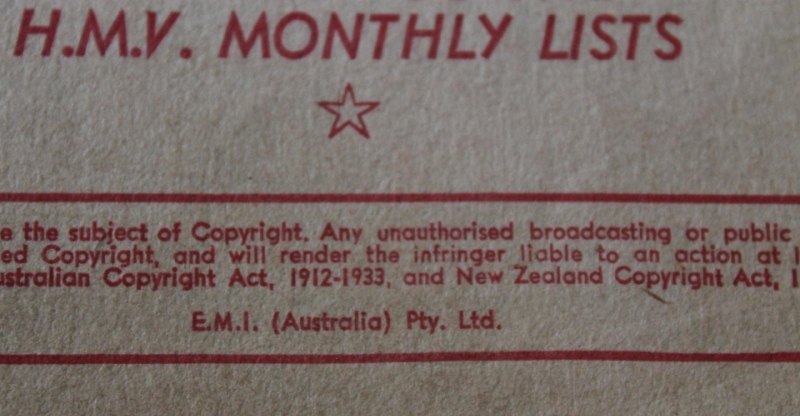
References
1. Gramophone Company. (2014, January 31). In Wikipedia, The Free Encyclopedia. Retrieved from http://en.wikipedia.org/w/index.php?title=Gramophone_Company&oldid=593318673
2. The history of 78 RPM recordings - a brief guide to aid in cataloguing, retrieved from:http://www.library.yale.edu/cataloging/music/historyof78rpms.htm
3. Nipper. (2014, June 17). In Wikipedia, The Free Encyclopedia. Retrieved from http://en.wikipedia.org/w/index.php?title=Nipper&oldid=613353784
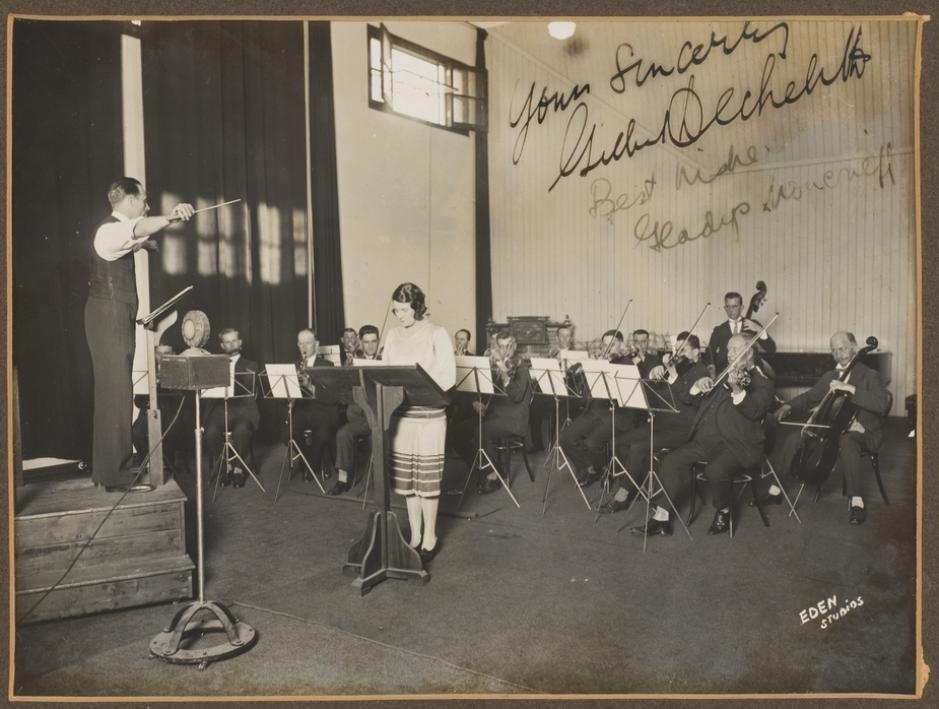
Gladys Moncrieff, singer, records with orchestra conducted by Gilbert Dechelette, HMV Studios, Sydney, ca. 1928-1932 / photographer Eden Studios. Creator Eden Photo. Studios (Melbourne and Sydney) Call Number P1 / 1180 Digital Order No. a4358080, courtesy the State Library of NSW.
Some of our Collection
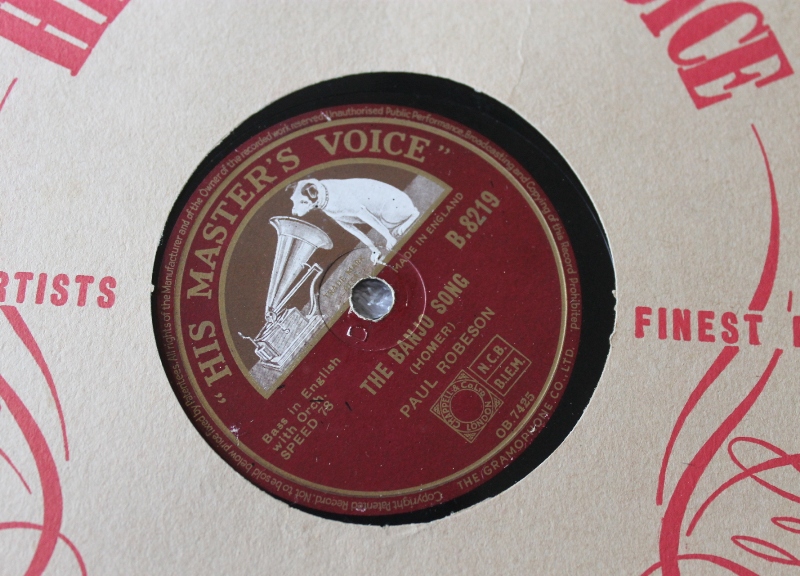
The Banjo Song – Paul Robeson – 1934 - The other side of this record, "St Louis Blues"
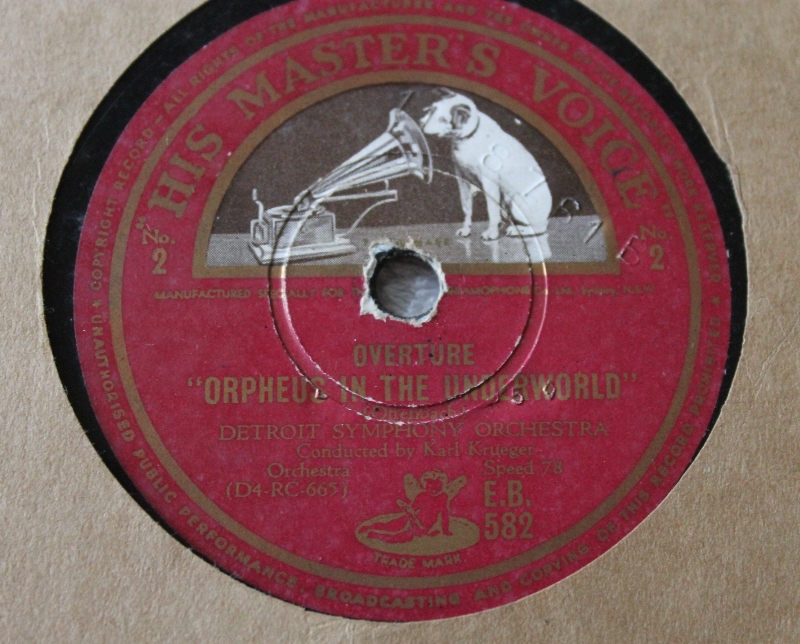
Orpheus in the Underworld – Detroit Symphony Orchestra – conducted by Karl Krueger
Karl Krueger was with Detroit Symphony Orchestra from 1944 - 1949. In the US was called: Offenbach: Orpheus in Hades Overture
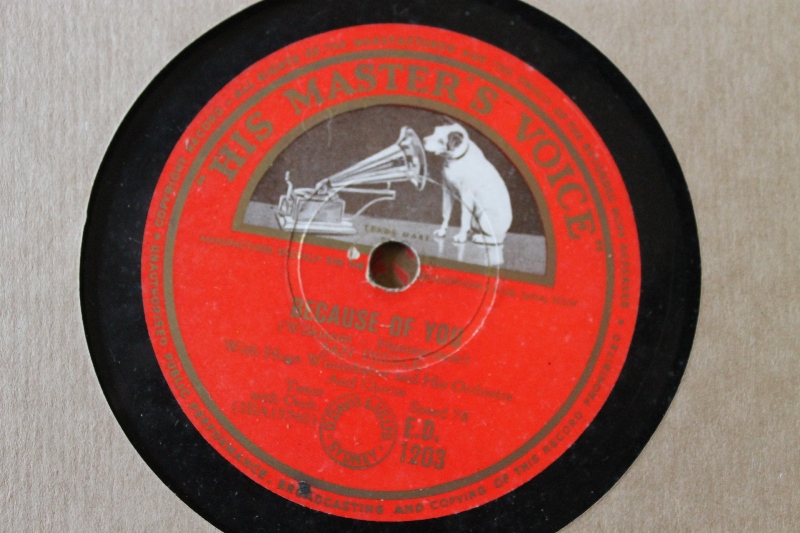
What Is A Boy?/Because of You – Jan Peerce – with Hugo Winterhater and his orchestra – released 26th of May, 1951 – was doing well in August same year
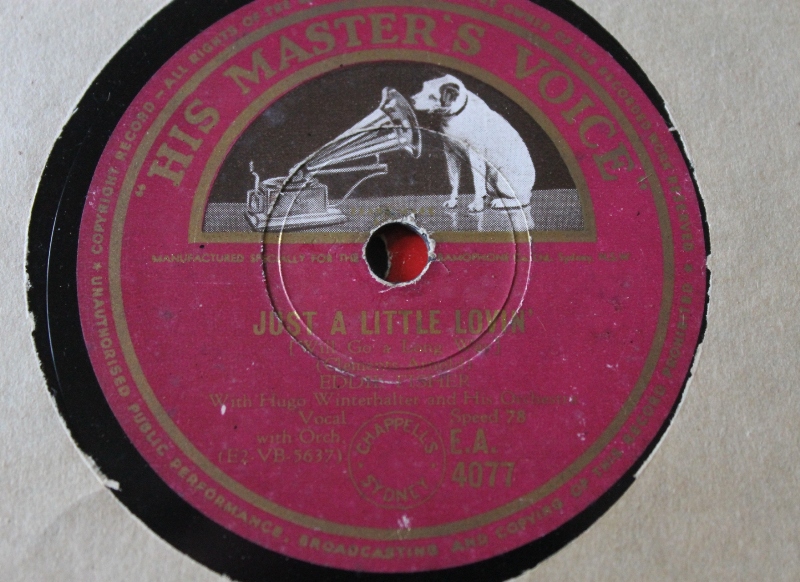
Just A Little Lovin’ (Will Go A Long Way) – Eddie Fisher - 1952
(Eddy Arnold / Zeke Clements) - Eddy Arnold - 1948, Eddie Fisher - 1952, Ray Charles - 1962, Dean Martin - 1963, Shirley Horn – 1993. Also recorded by: Bing Crosby; Bob Wills; David Houston; Lon Harmon; Patty Clark; Johnny Mac.
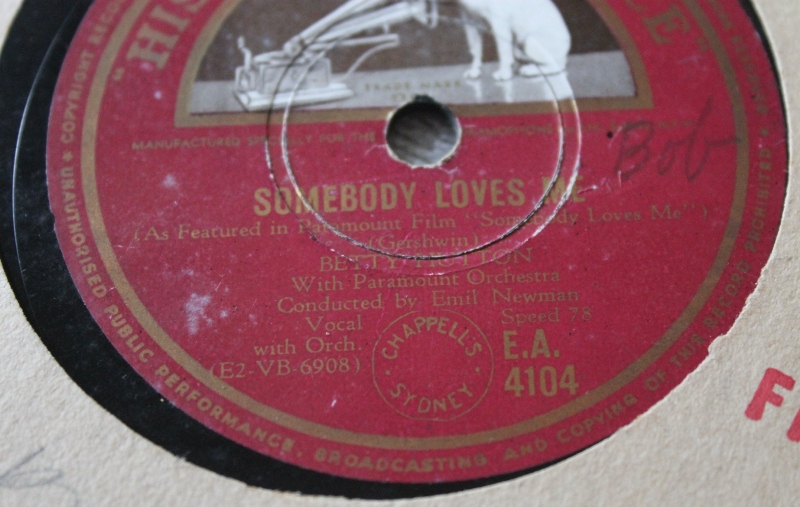
Somebody Loves Me (Gershwin) Betty Hutton with Paramount Orchestra – Other side: Jealous – Betty Hutton and Pat Morgan – 1952;From the album for the film "Somebody Loves Me"
Offenbach: Orpheus in Hades Overture - Karl Krueger/Detroit Symphony
Extras:
A definition of phonographer in the same moanth and year Mr. Edison began adding a new meaning to this word:
TO THE NEWSPAPER PROFESSION.BY REV. T. DE WITT TALMAGE.THE great Armageddon of the nations is not to be fought with swords, but with steel pens; not with bullets, but with type; not with cannon, but with Hoe's ten-cylinder presses. Men of the press, under God you are to decide whether the human race shall be saved or lost. What long strides your profession has made in influence and power since the day. When Peter Sheffer invented cast type, and because two books were found just alike they were ascribed to the work of the devil; and books were printed on strips of bamboo; and Rev. Jesse Glover originated the first American printing press; and the Common Council of New York in solemn resolution offered forty pounds to any printer who would come there and live; and when the speaker of the House of Parliament, in England, announced with indignation, that the public prints had recognised some of their doings-until in this day when we have in this country about five hundred skilled phonographers, and about five thousand newspapers printing in the year 1874 one billion five hundred million copies. What vast progress since the day when Cardinal Wolsey declared that either the printing press must go down, or the church of God must go down, to this time, when the printing press and the pulpit are in combination. One of the great trials of this newspaper profession is the fact that they are compelled to see more of the shams of the world than any other profession. From the editorial and reportorial rooms, all the follies and shams of the world are seen day by day, and the temptation is to believe neither in God, man nor woman. It is no surprise to me that in your profession there are sceptical men. I only wonder that you-believe anything. Another great trial of the newspaper profession is inadequate compensation. Since the days of Hazlitt and Sheridan and John Milton, and the wailings of Grub-street, London, literary toil, with very few exceptions, has not been properly requited. When Oliver Goldsmith received a friend in his house, he, the author, had to sit on the window, because there was only one chair. Linnaeus sold his splendid work for a ducat.. De Foe, the author of two hundred and eighteen volumes, died penniless. The learned Johnson dined behind a screen because his clothes were too shabby to allow him to dine with the gentlemen who, on the other side of the screen, were applauding his works. The world seems to have a grudge against a man who, as they say, gets his living by his wits ;' and the day labourer says to the man of literary toil:" You come 'down here, and shove a plane, and hammer a shoe last, and break cobblestones, and earn an honest living as I do, instead of sitting there in idleness scribbling !"But God knows that there are no harder worked men in all the earth than the newspaper people of this country. It is not a matter of hard times; it is a characteristic of all times. Men have a better appreciation' for that which appeals to the stomach than for that which appeals to the brain. They have no idea of the immense financial and intellectual exhaustions of the newspaper press. They grumble because they have to pay five cents a copy, and wish they had only to pay three, or, paying three, they wish they had only to pay one. While Rogers of the Boston Journal dies worth a million and a half of dollars, and Swaine of the Philadelphia Ledger dies worth three million dollars, and Henry J. Raymond dies worth five hundred thousand dollars, and James Gordon Bennett dies worth five million dollars, the vast majority of newspaper people in this day have a struggle for livelihood. Another great trial of the newspaper profession is the diseased appetite for unhealthy intelligence. You blame the newspaper press for giving such prominence to murders and scandals. Do you suppose that so many papers would give prominence to these things if the people did not demand them ? Now, you are a respectable man, an intelligent man, and a paper comes into your hand. You open it and there are three columns of splendidly written editorials, recommending some moral sentiment or evolving some scientific theory. In the next column there is a miserable contemptible divorce case. Which do you read first ? You dip into the editorial long enough to say :-" Well, that's very ably written," and you read the divorce case from the. Long primer type at the top to the nonpareil. Type at the bottom, and then you ask your wife if she has read it. I make no apology for a debauched newspaper, but I am saying these things in order to divide the responsibility between those who print and those who read. Well, my friends, we will soon get through writing and printing and proof-reading and publishing. What then ? Our life is a book. Our years are the chapters. Our months are the paragraphs. Our days are the sentences. Our doubts are the interrogation points. Our imitation of others the quotation marks. Our attempts at display, a dash. Death the period. Eternity the peroration. O God, where will we spend it ? TO THE NEWSPAPER PROFESSION. (1877, May 26). The Bacchus Marsh Express (Vic. : 1866 - 1918), p. 3. Retrieved from http://nla.gov.au/nla.news-article88347885
News of this wonderful new invention in Australia:
THE PHONOGRAPH. (From the Times.) Not many weeks have passed since we were startled by the announcement that we could converse audibly with each- other, although hundreds of miles apart, by means of so many miles of wire with a little electro-magnet at each end, yet we are on the point of realising some of the many advantages promised by the telephone. Another wonder is now promised us— an invention, purely mechanical in its nature, by means of which words spoken by the human voice can be so stored and reproduced at will over and over again, hundreds, it may be thousands, of times. What will be thought of a piece of mechanism by means of which a message of any length can be spoken on to a sheet of metal, that sheet sent by post to any part of the world and the message absolutely, re-spoken in the very voice of the sender purely mechanical agency. What, too, shall be said of a in new machine by means of which the old familiar voice of one who is no longer with us on earth can be heard speaking to us in 'the very tones and measure, to which our ears, were once accustomed ?. .The highly ingenious apparatus by which this wonder is effected is the invention of Mr. Thomas A. Edison, of Maniowe park, New Jersey; U.S. A., the electrical adviser to the Western Union Telegraph Company. Mr. Edison who is well known in the States, and scarcely less so in England, for several valuable practical applications of electrical science, among Mr. Edison's other inventions being an exceedingly well-arranged telephone. To the present invention Mr. Edison has given the name of the Phonograph, and it depends for its action upon certain well known laws in acoustics. The Phonograph is composed of three parts mainly— namely, a receiving, a recording, and transmitting apparatus. The receiving apparatus consists of a curved tube, one end of which is fitted with a mouthpiece for the convenience of speaking into it. The other end is about two inches in diameter, and is closed in with a disk or diaphragm of exceedingly thin metal, capable of being thrust- slightly outwards or vibrated upon gentle pressure being applied to it from within the tube. To the centre-of this diaphragm— which forms a right angle with the horizon— is fixed a small blunt steel pin, which, of course, partakes of the vibratory motion of the diaphragm. This arrangement is carried on a table and is fitted with a set screw, by means of which it can be adjusted relatively to the second part of the apparatus — the recorder. This is a brass cylinder, about four, inches in length and four inches in diameter, cut with a continuous V groove from one- end to the other, so that it in effect represents a large screw. Measuring along this cylinder from one end to the other there are 10 of these grooves to the inch, or about 40 in the whole length. The total length of this continuous groove, or screw-thread, is about 42 feet— that is to say; that would be the length of the groove if it were stretched out in a straight line. This cylinder is mounted on a horizontal axis or shaft, carried in bearings at either end, and having its circumferential face presented to the steel point of the receiving apparatus. The shaft is prolonged for four inches or so beyond the ends of the cylinder, and one of the prolongations is cut with a screw thread and works in a screwed bearing. This end terminates in a handle, and as this is turned round the cylinder is not only revolved, but by means of the screwed spindle is caused to travel the whole length in front of the steel point, either back wards or forwards. We now see that if the pointer be set in the groove in the cylinder at its commencement and the handle turned, the groove would be traversed over the point, from beginning to end, or, conversely, the point would always be presented to the groove. A voice speaking in the receiver would produce waves of sound- which would cause the point to enter to greater or less depths, all to this groove according to the degree of intensity given to the pressure upon the diaphragm set up by the vibrations of the sound produced. This, of course, of itself would mean nothing; but in order to arrest and preserve these sound-pressures, a sheet of tin-foil is interposed, the foil being inelastic and well adapted for receiving impressions. This sheet is placed around the cylinder and its edges lightly fastened together by mouth-glue, forming an endless band, and held on the cylinder at the edges by the india-rubber rings. If a person now speaks into the receiving tube and the handle of the cylinder be turned it will be seen that the vibration's of the pointer will be impressed upon that portion of the tinfoil over the hollow groove and retained by it. These impressions will be more or less deeply marked according to the modulations and inflexions of the speaker's voice. We have now a message verbally imprinted upon a strip of metal, Sound has, in fact, been converted into visible form, and we have now to translate that message by reconverting it into sound. We are about, in effect, to hear our own voice speaking from a machine the words which have just fallen from our lips. To do this we require the third portion of Mr. Edison's apparatus—the transmitter. This consists of what may be called a conical metal drum, having its larger end open, the smaller end, which is about 2in. in diameter, being covered with paper which is stretched taut as is the parchment of a drum-head. Just in front of this paper diaphragm is a light flat steel spring, held in a vertical position and terminating in a blunt steel point projecting, from it and corresponding with that on the diaphragm of the receiver. The spring is connected with the paper diaphragm of the transmitter by means of a silken thread, which is placed just' sufficiently in tension to cause the outer face of the diaphragm to assume a slightly convex form. This apparatus is placed on the opposite side of the cylinder to the receiver. Having set the latter apparatus back from the cylinder and having, by turning the handle in a reverse direction, set the cylinder back to what we may term the zero point, the transmitting apparatus is advanced towards the cylinder by means of a set screw until the steel point rests without absolute pressure in the first indentation made by the point of the receiver. If now the handle be turned at the same speed as it was when the message was being recorded, the steel point will follow the line of impression and will vibrate in periods corresponding to the impressions previously produced on the foil by the point of the receiving apparatus. Vibrations of the requisite number, and depth being thus communicated to the paper diaphragm, there will be produced precisely the same sounds that in the first instance were required to produce the impressions formed on the tin foil. Thus the words of the speaker will be heard issuing from the conical drum in his own voice, tinged however, with a slight metallic or mechanical tone. If the cylinder be revolved more slowly than when the message was being recorded, the voice assumes a bass-tone if more quickly, the message is given with a childish treble. These variations occur according as the vibrations are more or less frequent. Such is the apparatus, and it promises to be one of the most remarkable of the recent marvels of science. The machine we have described is the first Mr. Edison has made, but he is now constructing one to be set in motion by clock-work, the cylinder being 15 inches long. In the present machine, for recording a long message, as soon as one strip of the tin foil is filled, it is removed and replaced by others until the communication has been completed. In using the machine for the purpose of correspondence the: metal strips are removed from the cylinder and sent to the person with whom the speaker desires to correspond, and who must possess a machine similar to that used by the sender. The person receiving the strips places them in turn on the cylinder of his apparatus, applies the transmitter, and puts the cylinder in motion, when he hears his friend's voice speaking to him from the indented metal and he can repeat the contents of the missive as often as he pleases until, he has worn the metal through. The sender can make an indefinite number of copies of his communication by taking a plaster of Paris cast of the original strip and rubbing on impressions from it on a clean sheet of tin foil it will thus be seen, as we stated at the commencement of this article, that the voices of those who have left us, either forever or a season only, can be heard talking with us if we so desire it. The invention has been so recently, and so quickly developed into existence by Mr. Edison that he himself can hardly say what its practical value is or will prove to be. Numerous applications suggest themselves, but beyond those to which we have alluded, it is difficult to say with precision how they would work out in practice. In cases of dispositions, it might be of the highest importance to have oral evidence mechanically reproduced in a court of justice. Authors too, may perhaps be saved the trouble of writing their compositions. THE PHONOGRAPH. (1878, April 26). Illawarra Mercury(Wollongong, NSW : 1856 - 1950), p. 4. Retrieved fromhttp://nla.gov.au/nla.news-article135687416
SCIENCE-INVENTION CONSTRUCTION. The Phonograph. Two very successful exhibitions of the phonograph have been made in London, and there can no longer be any doubt that the new instrument has the "promise and potency" of great things in the future. At a recent meeting of the Physical Society two phonographs were shown, one of which was constructed by that well known mechanician, Mr. Stroh, and is, therefore, an improvement upon the original sent over by Mr. Puscus, Mr. Edison's agent. We reproduce from Engineering an engraving of the form adopted by Mr. Edison and that devised by Mr. Stroll. In fig.1 we have a brags cylinder mounted on a spindle carrying at one end a heavy fly-wheel, and at the other, a winch handle. The spindle or axis has a screw-thread, and works in a screwed bearing, the pitch of the screw corresponding to that of a spiral groove turned in the face of the brass cylinder. Over the latter is laid a strip of tolerably stout tinfoil, and the vibrating diaphragm is adjusted so that its style or point will traverse a spiral line immediately over the groove in the cylinder. On turning the handle, and - speaking to the diaphragm, a series of indentations are made in the foil, but it is of the first importance to maintain a regular rate of rotation, and have some means of recording what the speed actually is. To control to some extent the speed of rotation, Mr. Edison adopted the heavy fly-wheel seen in fig. 1, but Mr. Stroll has devised an ingenious form of governor, shown in fig. 2. In fig. 3 is exhibited, in an .exaggerated form, the indentations produced in the tinfoil by the style of the diaphragm, and it is assumed that the pointer, having produced them by vibrations of the diaphragm to which it is affixed, can also, when the action is reversed, reproduce exactly identical vibrations in the diaphragm, and consequently the sounds which gave rise to those vibrations. To look, however, at apiece of the indented tinfoil it would seem almost impossible that the minute and occasionally microscopic marks thereon should be capable of throwing a metallic diaphragm into a state of complex vibration, in which each oscillation is possibly of different amplitude to that which preceded or succeeded it still, from the demonstrated necessity of making the repeating cylinder rotate at exactly the same velocity as the recording instrument(one instrument answers for both purposes), it is practically demonstrated that it must be the purely mechanical differences in the indentations that cause the diaphragm to repeat the sentences stamped upon the foil. The latter, of necessity, is made to lie very closely and smoothly on the cylinder, and is held in place by a brass cap at each end.
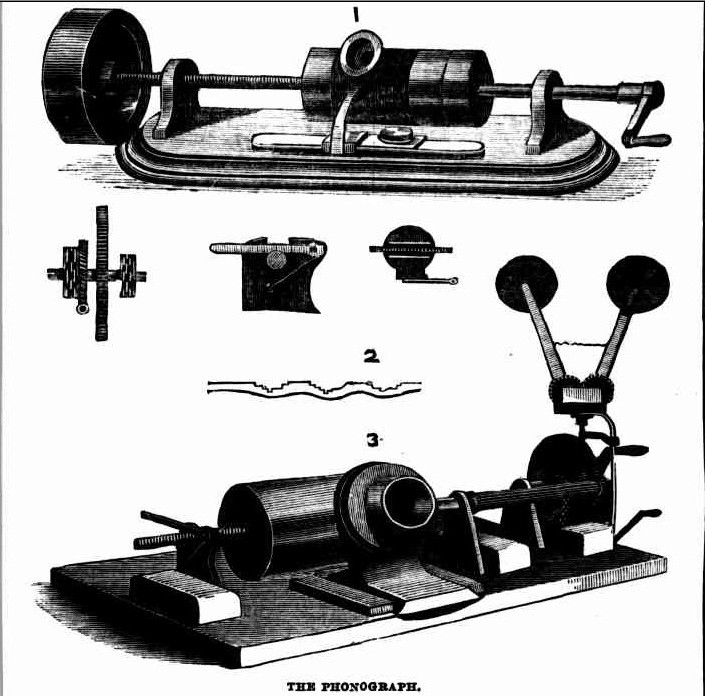
The original instrument had, as the reproducer, a more delicate diaphragm than that employed to indent the tinfoil; but in the instrument shown in fig. 1, Mr. Edison dispenses with the special reproducer, and makes the one metallic diaphragm answer both as receiver and speaker. The instrument made by Mr. Pidgeon has two diaphragms, one of paper and the other of metal, and at the recent meetings it was considered to give the better results of the two; but Mr.Edison prefers, we believe, to use only one diaphragm, and Mr. Stroh follows him-in fact, his -instrument is the same with the exception that instead of the fly-wheel, he has introduced some very ingenious controlling mechanism. The speed of rotation must obviously be perfectly uniform to obtain the best results, but even with a fly-wheel it is very difficult, if not impossible, to secure a non-varying peripheral velocity; accordingly, Mr. Edison has adapted a clock-train movement as the driving mechanism, and so far with a considerable degree of success. Expanding the idea, he has had a clock constructed, which, instead of striking the hours, reproduces the tones of a voice which once indented the phonograph, and strangers have startled at hearing a clock say " Six o'clock, time for dinner," or "midnight, time for bed." In Mr. Stroh's apparatus, which is worked by hand, the fan or governor consists of two brass discs attached to the upper ends of two light levers geared together at their lower ends, and so arranged that they fly out symmetrically on each side of the axis of rotation bf the vertical shaft. " When the instrument is started (by taking off the pressure of a small cork-lined brake-block, shown in the detail sketch, which passes against the cylindrical head of the fly-spindle), the discs fly out under the influence of centrifugal force, and the resistance of the air to the motion of the spindle is increased by the increase in the diameter of the path of rotation if the speed become too great." On the contrary, should the speed of rotation tend to fall off, a spiral spring draws the levers and the discs together, and they offer less resistance to the rotation of the spindle.
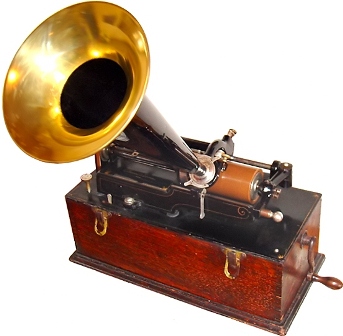 It will be understood that, although the governor is a much more useful appliance than the fly-wheel, it by no means insures perfect uniformity of motion, which apparently can only he obtained by means of clock work. Numerous applications have been suggested for the phonograph, many of them extremely visionary. It is, however, a most remarkable invention, the future of which cannot be foreseen. SCIENCE—INVENTION— CONSTRUCTION. (1878, June 15).Australian Town and Country Journal (Sydney, NSW : 1870 - 1907), p. 21. Retrieved from http://nla.gov.au/nla.news-article70613811
It will be understood that, although the governor is a much more useful appliance than the fly-wheel, it by no means insures perfect uniformity of motion, which apparently can only he obtained by means of clock work. Numerous applications have been suggested for the phonograph, many of them extremely visionary. It is, however, a most remarkable invention, the future of which cannot be foreseen. SCIENCE—INVENTION— CONSTRUCTION. (1878, June 15).Australian Town and Country Journal (Sydney, NSW : 1870 - 1907), p. 21. Retrieved from http://nla.gov.au/nla.news-article70613811
Right: Edison Phonograph - 1899
Gramophone Exhibition. Mr J. Tucker, representative of the National Mutual Life Assurance Society, entertained the children of the Cairns Roman Catholic School last Tuesday, with a series of Gramaphone melodies. All the little ones were keenly interested, and will no doubt re-member the National Mutual when they arrive at that stage of life at which all wise -young people think about insuring their lives. An exhibition of the wonderful voice re-producer will be given by Mr Tucker at the State School some afternoon this week. Gramaphone Exhibition. (1900, September 18). Morning Post(Cairns, Qld. : 1897 - 1907), p. 2. Retrieved from http://nla.gov.au/nla.news-article42943050
HIS MAJESTY'S VOICE Gramophones in Schools. The King and Queen will, on Empire Day, May 24, address, through the medium of the gramophone, children in elementary schools in all parts of the Empire. The Governor General has received a cable message to the effect that every effort is being made to distribute the records throughout the British Dominions for use on the day or as soon as possible afterwards. The records, which, may be purchased by educational authoritiesor private persons, will be suitable for use on any gramophone. All profits resulting from the sales will be placed at the disposal of the King, who ;h as, expressed the wish that the money should be distributed to the children's hospitals, oi" children's wards in general hospitals, or devoted to some other similar, purpose in those ' parts of the Empire in which the money' is collected. HIS MAJESTY'S VOICE. (1923, April 13). The Wyalong Advocate and Mining, Agricultural and Pastoral Gazette (NSW : 1900 - 1928), p. 3. Retrieved from http://nla.gov.au/nla.news-article108627337
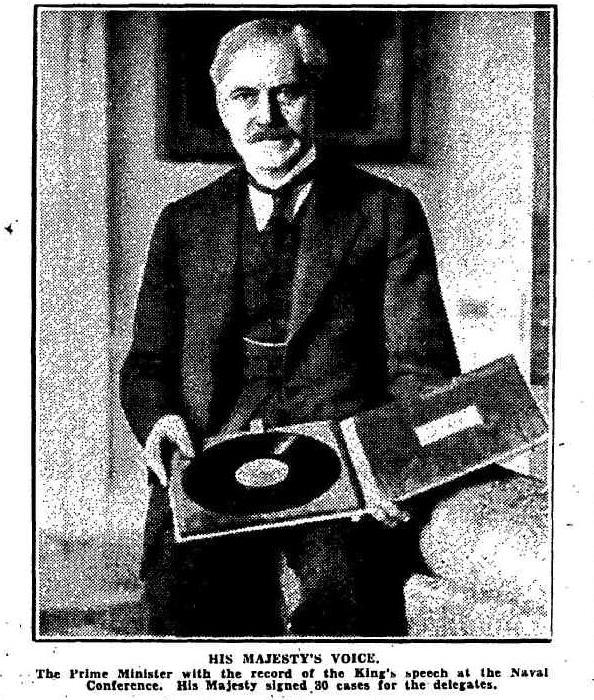 HIS MAJESTY'S VOICE. The Prime Minister with the record of the King's speech at the Naval Conference. His Majesty signed 30 cases for the delegates. HIS MAJESTY'S VOICE. (1930, July 2). The World's News(Sydney, NSW : 1901 - 1955), p. 7. Retrieved from http://nla.gov.au/nla.news-article136305847
HIS MAJESTY'S VOICE. The Prime Minister with the record of the King's speech at the Naval Conference. His Majesty signed 30 cases for the delegates. HIS MAJESTY'S VOICE. (1930, July 2). The World's News(Sydney, NSW : 1901 - 1955), p. 7. Retrieved from http://nla.gov.au/nla.news-article136305847
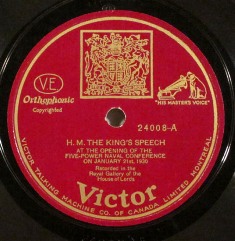
Prime Minister of Australia in 1930 was James Scullin. These recordings are still for sale now - His Majesty King George V, H.M. The King’s Speech at the Opening of the Five-Power Naval Conference on January 21st, 1930 (10" 78 rpm single, Victor 24008, 1930 Canadian custom label). $10.00
PHONOGRAPH IN 1877. Mr. Thomas A. Edison has been greatly amused, as well as interested, by a clipping from a Canadian newspaper's "Looking Backward" column, which, under the heading "Fifty Years Ago," stated:— A New Jersey electrician by the name of Edison is said to have invented an instrument by which the sound of the human race can be impressed on a record and the tones reproduced at any subsequent period; people, however, regard this extraordinary rumour as the veriest bosh. It is good to be able to add that the inventor still enjoys good health, and can extract amusement from the criticisms of his work in 1877. PHONOGRAPH IN 1877. (1928, March 3). The Australasian(Melbourne, Vic. : 1864 - 1946), p. 6. Retrieved from http://nla.gov.au/nla.news-article140794139
'HIS MASTER'S VOICE' LATEST RECORDS. [Each week, in this place, reviews of the latest H.M.V. records will appear. It is hoped that they may prove of value to thousands of enthusiasts of the gramophone. All these records are obtainable from W. H. Paling and Co., Sydney and Brisbane.] Another remarkable triumph in recording has been added to the already voluminous list of H.M.V. masterpieces, in the shape of Tchaikovsky's Concerto in B flat minor, played by Mark Hambourg and the Royal Albert Hall Orchestra, conducted by Sir Landon Ronald. There are four double-sided records, which cost at the rate of 8/ each, that is, £1/12/ for the set, including 'a free album. 'D. 11:50…. "HIS MASTER'S VOICE" LATEST RECORDS. (1927, May 29).Sunday Times (Sydney, NSW : 1895 - 1930), p. 16. Retrieved from http://nla.gov.au/nla.news-article128508554
J V. Connors (Munimulgum, via Casino):'Happy to introduce another enthusiast to our readers. Brunswick dance records certainly are excellent, though I don't see that they are better on the whole than those of other principal companies. "His Master's Voice**and Columbia discs are of course, reliable all round. Yes. I do think the Parlophones are good records. In fact, I'm a particular enthusiast where these discs are concerned, not because they are more meritorious than other makes, but because they have splendid recording and artists, and—"this is the big point—they all are sold at the democratic price of 6/, but for a couple of special discs. Here, of course, I have been speaking of 12-inch numbers) The 10-inchdiscs are excellent, also. Admittedly the Parlos of a year or so ago wore very quickly, but the present-day products, I find just as wearable as any others. Might I let you into a little secret—the 10-inchParlophones are pressed at the Columbia factory in Homebush, and therefore are identical in material. Other readers will appreciate your recommending the following Brunswicks: 3135, "Mary Lou" and "Do You Believe in Dreams"; 3096, "Sweet and Low Down" and "Whistle Away Tour Blues";3208, "Adelai" and "After Long Absence." QUESTIONS ANSWERED. (1927, August 6). The World's News(Sydney, NSW : 1901 - 1955), p. 11. Retrieved from http://nla.gov.au/nla.news-article130604235
Researched and compiled by A J Guesdon, 2014.